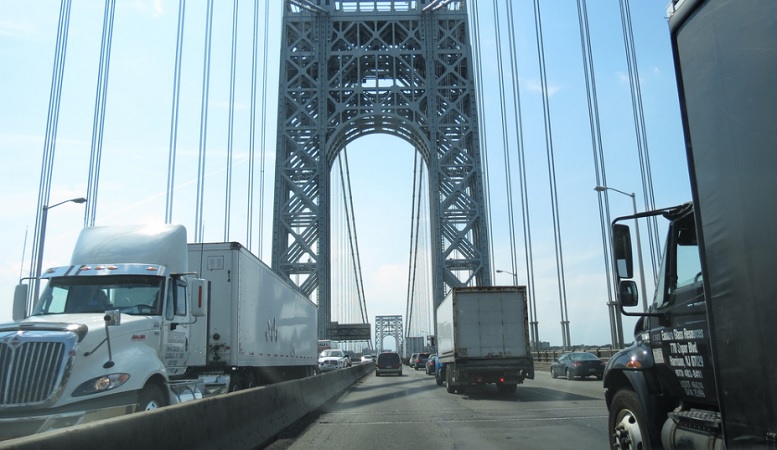The recently-released annual report from the American Transportation Research Institute, a non-profit trucking industry research group, identifies the top locations in the country where truckers encounter delays. Not surprisingly, New Jersey has once again cracked the top three.
According to the report, the George Washington Bridge approach where Interstate 95 and NJ Route 4 meet in Fort Lee is the second-most congested bottleneck in the nation for truckers. The report found that truck traffic approaching the George Washington Bridge is slowest on average between 7 and 9 a.m., when the average speed is below 25 mph. Traffic slows again to about 30 mph in the evening rush from 5 to 7 p.m.
But it is important to consider that this congestion is at least in part attributable to the fact that the New York Metro area is an anomaly when it comes to freight movement. While almost 40 percent of U.S. intercity freight moves by rail, in New York City and its surrounding counties, it’s only 1.8 percent. And it’s not just New York that feels the impact: over 90 percent of freight that crosses the Hudson River is moved by truck, clogging up New Jersey’s roads as well. What’s more, these problems will only be exacerbated in the coming decades as New Jersey’s truck traffic is expected to increase. According to the North Jersey Transportation Planning Authority’s Plan 2040, with overall commodity flows into, out of, and within New Jersey expected to increase by about 43 percent but freight movement modal share expected to remain the same, the number of trucks travelling on New Jersey’s major highways are expected to increase significantly — 6,000 more trucks per day on segments of I-95, and 2,500-3,000 more trucks per day on segments of I-78 and I-287.
This is an already untenable situation that, without action, is only going to get worse. But with both the Trump administration and senate Democrats floating proposals for upgrading America’s infrastructure, the Port Authority, regional businesses and elected officials should be calling for some of those funds to be spent on a Cross Harbor Freight Rail Tunnel. The proposed tunnel would allow freight trains to cross from New Jersey to Brooklyn, enabling goods to reach locations east of the Hudson by rail instead of truck (or barge). Such a connection could remove 500,000 trucks annually from the George Washington Bridge and surrounding counties. That translates into a reduction of 157,000 fewer truck vehicle miles traveled per day region-wide, with almost two-thirds of that reduction in northern New Jersey alone. Getting all of those trucks off the road would make a serious dent in the congestion problem.
But reduced congestion isn’t the only potential benefit of this project. These large commercial vehicles are also major contributors to road and bridge deterioration and diminished air quality in the Garden State and throughout the region. There’s a significant social cost, too, as truck traffic has implications for safety and quality of life. Consider these additional benefits:
- Decreased wear and tear on our infrastructure, as one 80,000 pound tractor trailer causes the same damage to our roads, highways, and water mains as 9,600 automobiles
- Decreased emissions by as much as 75 percent
- Improved pedestrian and roadway safety, as truck crashes are more likely to result in pedestrian fatalities than crashes involving passenger vehicles
- And increased economic opportunity, as fewer trucks on the region’s highways helps to reduce congestion, improve the flow of goods, and create jobs.
Although a Record of Decision for the Tier I EIS was issued in January of last year, there is no timeline for the Tier II EIS, mostly because no money has been allocated in the proposed Port Authority Capital Plan. As the Port of New York and New Jersey continues to set records year after year for annual cargo volumes, New Jersey’s roads will not be able to absorb the anticipated truck traffic. If President Trump and Senate Democrats are serious about fixing the nation’s infrastructure and growing the economy, investing in freight rail – a $274 billion industry supporting almost 1.5 million American jobs – would be a good bet. The Cross Harbor Rail Tunnel is a worthy project of national significance and must be a part of any national infrastructure plan.


Rumor has it that the main reason the PA was created in the first place was to build the rail tunnel mentioned above. Billions upon billions long gone, but no hint of a viable freight rail connection yet to the 4 counties of Long Island. How about we do this BEFORE billions more are wasted by PA on a new bus terminal that won’t solve any problems.
It certainly is time to not only reconsider a Cross-harbor Freight Tunnel, it’s time to start drafting plans for a workable yard facility for both sides of the the Hudson River. Here in New Jersey, there are several viable locations.
The switch in the rail business from direct car load freight to intermodal has been very detrimental to NY/NJ metro area. It was a mistake not to encourage railroads and shippers to utilize direct rail service. One box car can handle 3 to 5 truck loads. There should be some kind of program to facilitate direct freight service for industry. Pennsylvania, North Carolina and other states have grant program’s to help finance rail siding construction. California is trying to get all industrial developments to consider rail access in there planning and construction. With GPS and wireless technology, it has become much easier to manage and improve old fashioned car load freight service, which has become a growth industry again in North America. Hopefully one day the New York City area can benefit from this.
Why not just use the existing tunnels in the middle of the night, when there’s plenty of capacity? I know Amtrak currently forbids freight in the North River tunnels, but figuring out a way to do this safely seems by far the easiest, cheapest, and quickest solution. Send them through to Sunnyside or over Hell Gate to the Bronx. No obscenely over-budget and delayed new tunnel needed. Besides, any new tunnel dug across the river or harbor should [also] handle passengers
Would a cheaper and better alternative to the tunnel be a rebuilding of the Poughkeepsie Bridge to be both hiking and rail components, linking the bridge to the Southern Tier, CSX and NS by reinstating the rail routes that used to serve it with better grades and curves and also improve the links on the New York and Connecticut side to the Harlem Division and the various New Haven lines? Tunnels are very expensive and can’t handle certain hazardous goods. Alternatively, if the tunnel is built should the whole line also have an every 15 minute all day service from New Jersey to the Bronx with stations at all points where the line crosses the Subway and the LIRR?
[…] Tri-State: Instead of Airport Transit, Port Authority Should Invest in Freight Rail […]
They have ROW problems with Poughkeepsie area municipalities. They don’t want it. They’ve been built over and re-mapped the ROW. The existing bridge was wood and it burned. Answer: easy and faster to do a tunnel.
The Hudson tunnels would not accommodate freight, night or day. Ride along R1-9 in NJ and you see the two-high container cars which is the standard. The Greenville to Bay Ridge tunnel to Brooklyn/Queens must be deeper. Due to the long incline up into Brooklyn from the very deep freight tunnel under the harbor which must accommodate the new PANAMAX ships the harbor was dredged to a new depth. The tunnel will break ground not in Bay Ridge, not in Sunset Park, but two miles inland in Boro Park.
We’re lucky this tunnel wasn’t already there. We would have to collapse it for the new ships, then replace it. The City is doing just that with the existing water siphon to Staten Island. Procrastination does pay.